#Interior Design Education
Text
interior designers in chennai
We are top interior designers in chennai, with a bunch of creative people, working, exploring and playing with. We love inspiring beautiful design and enjoy combining them to create world-class Designs.
Everything is possible because Chennai Home Decor Are Alive!
#interior design#interior design education#interior design services#interior design tips#interior design consultation
2 notes
·
View notes
Text
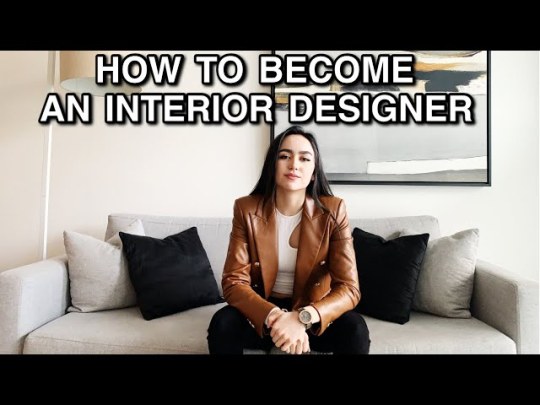
How to Become an Interior Designer in 15 Simple Steps | IVS SCHOOL ART AND DESIGN
Are you passionate about transforming spaces and creating beautiful, functional environments? If so, a career in interior design might be your calling. Here’s a comprehensive guide to becoming an interior designer in 15 simple steps.
An interior design course is a structured educational program that equips students with the essential skills and knowledge to create functional and aesthetically pleasing indoor spaces. Covering a wide array of topics such as design principles, space planning, color theory, materials and finishes, and the use of industry-standard software like AutoCAD, these courses provide a comprehensive foundation in both the theoretical and practical aspects of interior design. Students engage in hands-on projects, internships, and real-world applications, developing a professional portfolio that showcases their capabilities. By learning from experienced instructors and connecting with industry professionals, students not only stay updated on the latest trends but also build a network that can aid in career advancement. Whether opting for a certificate, diploma, or degree program, an interior design course is an invaluable step for anyone looking to turn their passion for design into a successful career. Best Interior Design Institute In Dehradun.
1. Understand the Role
Before diving into the field, it's essential to understand what interior designers do. They plan, research, coordinate, and manage enhancement projects, working closely with clients to meet their needs and preferences.
2. Assess Your Skills and Interests
Evaluate your natural talents and interests. Strong creativity, attention to detail, problem-solving skills, and an eye for color and design are crucial. Interpersonal and communication skills are also vital since you'll be working with clients and teams.
3. Research the Field
Spend time researching the industry. Read books, watch videos, and follow influential interior designers online. Understanding trends, market demands, and the different specialties within interior design can help you find your niche.
4. Get Formal Education
Pursue a degree in interior design from an accredited institution. A Bachelor's degree is often required and provides a solid foundation in design principles, history, theory, and practical skills. Some institutions offer specialized programs in areas like sustainable design or kitchen and bath design.
5. Take Relevant Courses
Enhance your education with courses in architecture, graphic design, or CAD (computer-aided design). These skills are essential for creating detailed plans and visualizations for your projects.
6. Build a Portfolio
Start compiling a portfolio of your work. Include sketches, mood boards, before-and-after photos of spaces you’ve worked on, and any school projects. A strong portfolio showcases your style, skills, and versatility.
7. Gain Practical Experience
Internships and entry-level positions are invaluable for gaining real-world experience. Work under experienced designers to learn the ropes of project management, client relations, and the day-to-day operations of a design firm.
8. Network with Professionals
Networking is crucial in the interior design industry. Attend industry events, join professional organizations like the American Society of Interior Designers (ASID), and connect with other designers and potential clients on social media platforms like LinkedIn and Instagram.
9. Obtain Certification
Consider getting certified by passing the National Council for Interior Design Qualification (NCIDQ) exam. Certification can enhance your credibility and career prospects. Requirements typically include a combination of education and work experience.
10. Stay Updated on Trends
Interior design trends constantly evolve. Keep up with the latest trends by subscribing to design magazines, following industry blogs, attending trade shows, and participating in continuing education opportunities.
11. Develop Your Style
While versatility is important, developing a unique style or specialty can set you apart. Whether it's minimalist design, sustainable interiors, or luxury spaces, having a signature style can attract clients looking for that specific aesthetic.
12. Learn Business Basics
If you plan to run your own design firm, understanding business fundamentals is crucial. Learn about contracts, budgeting, marketing, and client management. Consider taking business courses or workshops to build these skills.
13. Create a Strong Online Presence
A professional website and active social media profiles are essential for showcasing your work and attracting clients. Share your portfolio, design ideas, and industry insights. Platforms like Instagram and Pinterest are particularly effective for visual inspiration.
14. Seek Feedback and Continuous Improvement
Regularly seek feedback from clients, peers, and mentors. Constructive criticism can help you grow and refine your skills. Always look for ways to improve your designs and business practices.
15. Stay Passionate and Persistent
Becoming a successful interior designer requires passion and persistence. Stay motivated by continually seeking inspiration, challenging yourself with new projects, and never losing sight of why you chose this creative and rewarding career path.

Conclusion
Embarking on a career in interior design is a journey that combines creativity, technical skills, and business acumen. By following these 15 steps, you'll be well on your way to creating stunning spaces and leaving your mark on the world of design. Remember, every designer's path is unique, so embrace your journey and let your passion for design shine through in every project you undertake.
#interior design#Interiordeisgncourse#interior design institute#interior design course eligibility#interior design ideas#interior accessories#interior design education#best interior designer in Dehradun#noida#Best Interior Institute In Dehradun
0 notes
Text
The Importance of Client Relationships in Interior Design

The field of interior design offers a wealth of opportunities, and for those looking for flexibility and creative freedom, freelancing can be an ideal career path. Freelancing in interior design allows you to choose your projects, work with a variety of clients, and set your own schedule. However, it also requires a unique set of skills and strategies to succeed. Here’s a guide to exploring freelance opportunities in interior design and how the Indian Institute of Fashion & Design (IIFD) Kolkata can help you prepare for this dynamic career.
Understanding the Freelance Landscape
Freelancing in interior design involves working independently on projects without being tied to a single employer. This can range from residential and commercial projects to specialized areas like hospitality or retail design. The freelance landscape is diverse, and understanding the different niches can help you identify where your skills and interests align best. At IIFD Kolkata, we provide students with a comprehensive understanding of various interior design sectors, equipping them to make informed decisions about their freelance careers.
Building a Strong Portfolio
A strong portfolio is your primary tool for attracting clients. It should showcase a diverse range of projects and highlight your design skills, creativity, and technical proficiency. Include high-quality images, detailed project descriptions, and client testimonials if available. IIFD Kolkata offers portfolio development workshops and guidance, helping students create compelling portfolios that stand out in a competitive market.
Networking and Building Relationships
Networking is crucial for freelancers. Building relationships with other designers, architects, contractors, and potential clients can lead to referrals and repeat business. Attend industry events, join professional organizations, and engage in online communities related to interior design. IIFD Kolkata encourages networking by organizing industry interactions, guest lectures, and alumni meet-ups, providing students with valuable connections in the design community.
Marketing Yourself Effectively
Effective marketing is essential for attracting clients. Create a professional website showcasing your portfolio, services, and contact information. Use social media platforms like Instagram, Pinterest, and LinkedIn to share your work and connect with potential clients. Blogging about design trends and tips can also establish you as an expert in the field. At IIFD Kolkata, we offer courses on digital marketing and branding, helping students learn how to market themselves effectively.
Managing Projects and Client Relationships
Freelancers must manage all aspects of their projects, from initial consultations and design proposals to project execution and final delivery. Effective communication and organization are key to maintaining client satisfaction and managing multiple projects simultaneously. IIFD Kolkata’s curriculum includes training in project management and client relations, ensuring that students are well-prepared for the demands of freelancing.
Setting Rates and Handling Finances
Determining your rates can be challenging but is crucial for running a successful freelance business. Research industry standards, consider your experience level, and factor in project complexity when setting your rates. Additionally, keep track of your finances, including expenses, invoices, and taxes. IIFD Kolkata offers financial management workshops that teach students how to handle the business side of freelancing, ensuring they can maintain profitability.
Continuous Learning and Skill Development
The interior design industry is constantly evolving, and staying updated with the latest trends, technologies, and materials is essential for freelancers. Participate in workshops, online courses, and industry conferences to continue learning and refining your skills. IIFD Kolkata provides students with access to ongoing educational opportunities and resources, ensuring they remain at the forefront of the industry.
Conclusion
Freelancing in interior design offers unparalleled flexibility and the opportunity to work on a wide variety of projects. However, it requires a strong portfolio, effective marketing strategies, excellent project management skills, and continuous learning. One of the Best Interior Design Colleges in Kolkata, the Indian Institute of Fashion & Design - IIFD Kolkata is dedicated to preparing students for successful freelance careers by providing comprehensive education, practical experience, and valuable industry connections.
Ready to explore the exciting world of freelance interior design? Discover the programs at the Indian Institute of Fashion & Design - IIFD Kolkata that can equip you with the skills and knowledge to succeed. Our dynamic curriculum, experienced faculty, and supportive learning environment will help you launch and thrive in your freelance career. Apply now and start your journey with IIFD Kolkata!
#Client Relationships#Client#Relationships#Interior Design#Interior Designing#Interior Design Education#iifd#iifd kolkata#careers#interior design ideas
0 notes
Text
How virtual reality (VR) technology is revolutionizing the interior design industry. It covers the evolution of VR from basic 3D visualization to highly immersive, hyper-realistic simulations that allow clients and designers to interact with a virtual model of their spaces. Virtual reality (VR) technology, once the domain of futuristic fantasies and high-budget video games, has rapidly become a transformative tool in various industries.
0 notes
Text
Resources for Interior Design Colleges: Libraries, Studios, and Labs
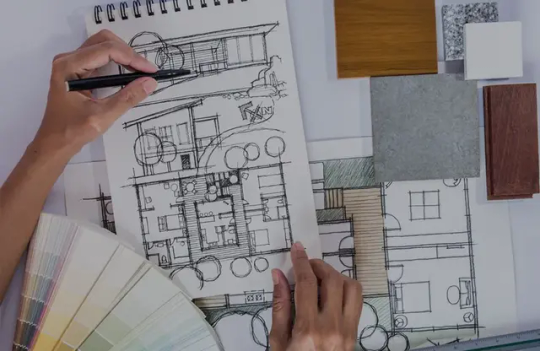
Interior design colleges provide students with the knowledge, skills, and experiences they need to succeed in the dynamic world of design. Central to this education are the resources available to students – from libraries filled with design inspiration to state-of-the-art studios and labs equipped with the latest technologies. In this article, we'll take a closer look at the essential resources for interior design colleges, highlighting how these resources foster creativity, innovation, and excellence in design education. Plus, if you're considering pursuing your interior design education with a reputable institution, don't forget to explore the resources available at the Indian Institute of Fashion & Design (IIFD) Kolkata.
Libraries:
Libraries are invaluable resources for interior design colleges, providing students with access to a wealth of design literature, periodicals, journals, and digital resources. These collections offer inspiration, research materials, and references for design projects, history, theory, and current trends. Many interior design colleges curate specialized collections focusing on architecture, interior design history, furniture design, materials, sustainability, and more. Additionally, libraries often offer quiet study spaces, research assistance, and interlibrary loan services to support students' academic pursuits.
Studios:
Design studios are the heart of interior design colleges, where students bring their creative visions to life through hands-on projects, experimentation, and collaboration. These spaces provide students with dedicated areas to sketch, draft, model, and prototype their design concepts using traditional and digital tools. Equipped with workstations, drafting tables, drawing boards, modeling materials, and presentation tools, design studios foster a dynamic and inspiring environment for creativity and innovation. Additionally, studios often serve as hubs for critique sessions, design reviews, workshops, and guest lectures, enriching students' learning experiences and fostering a sense of community and camaraderie among peers.
Labs:
Technology plays a crucial role in modern interior design education, and labs provide students with access to cutting-edge tools and software to support their design process. Computer labs equipped with industry-standard software such as AutoCAD, Revit, SketchUp, Adobe Creative Suite, and 3D modeling/rendering programs allow students to visualize and communicate their design ideas effectively. Fabrication labs equipped with laser cutters, 3D printers, CNC machines, and other prototyping tools enable students to create physical models, prototypes, and mock-ups of their designs. These labs provide students with opportunities to explore new techniques, experiment with materials, and push the boundaries of design innovation.
Material Libraries:
Material libraries are essential resources for interior design colleges, providing students with access to a wide range of materials, finishes, textiles, and samples for design projects. These libraries allow students to explore and compare different materials' textures, colors, properties, and sustainability characteristics, informing their material selection and specification decisions. Material libraries often collaborate with industry partners, manufacturers, and suppliers to curate up-to-date collections and host workshops, presentations, and material demonstrations for students. By engaging with material libraries, students gain practical knowledge and hands-on experience in materiality, fabrication, and construction techniques, enhancing their design skills and understanding.
Conclusion:
Resources such as libraries, studios, labs, and material libraries are essential pillars of interior design colleges, providing students with the tools, inspiration, and support they need to excel in their design education. By leveraging these resources, students can unleash their creativity, explore new ideas, develop technical skills, and realize their design visions. And if you're considering pursuing your interior design education with a reputable institution, don't forget to explore the resources available at the Best Interior Design College in Kolkata like the Indian Institute of Fashion & Design - IIFD Kolkata. With its commitment to providing students with access to state-of-the-art facilities, expert faculty, and industry connections, IIFD Kolkata offers a dynamic and inspiring environment for aspiring designers to thrive and succeed in the competitive world of interior design.
#iifd#education#careers#iifd kolkata#Interior Design#Interior Designing#Interior Design Education#Interior Design College#interiors#Education
1 note
·
View note
Text
Choosing the Right Color Palette for Your Home

When it comes to designing your home, selecting the perfect color palette is paramount. Colors have the power to influence mood, perception, and even behavior, making them a crucial aspect of interior design. Whether you're aiming for a serene sanctuary or a vibrant expression of personality, the colors you choose can make all the difference in achieving your desired ambiance.
Understanding Color Psychology
Before delving into the process of selecting a color palette, it's essential to understand the basics of color psychology. Different hues evoke distinct emotions and associations:
Red: Energetic, passionate, and bold.
Blue: Calming, serene, and trustworthy.
Yellow: Cheerful, optimistic, and vibrant.
Green: Refreshing, natural, and harmonious.
Purple: Regal, creative, and luxurious.
Neutral tones: Versatile, timeless, and sophisticated.
By considering the psychological effects of color, you can strategically incorporate hues that align with the atmosphere you wish to create within each space of your home.
Assessing Your Space and Lighting
Before finalizing your color palette, assess the natural light and dimensions of each room. Natural light can alter the appearance of colors throughout the day, affecting their intensity and undertones. Rooms with ample sunlight may accommodate deeper, richer shades, while those with limited light may benefit from lighter hues to maximize brightness and create an illusion of spaciousness.
Additionally, consider the architectural features and furnishings within each room. A cohesive color palette should complement existing elements, such as flooring, fixtures, and furniture, ensuring visual harmony throughout the space.
Exploring Color Schemes
There are various color schemes to consider when designing your home, each offering its unique aesthetic appeal:
Monochromatic: Utilizes variations of a single color for a clean, cohesive look.
Analogous: Combines colors that are adjacent on the color wheel for a harmonious, unified palette.
Complementary: Incorporates colors that are opposite each other on the color wheel for dynamic contrast and visual interest.
Triadic: Utilizes three colors equidistant from each other on the color wheel for a vibrant, balanced scheme.
Experiment with different color combinations to find the scheme that best reflects your personal style and complements the architectural features of your home.
Bringing Your Palette to Life
Once you've identified your preferred color palette, it's time to bring your vision to life. Start by testing paint samples on your walls to observe how they interact with the surrounding light and decor. Consider the mood and ambiance you wish to evoke in each room, adjusting shades and tones as needed to achieve the desired effect.
Incorporate your chosen colors strategically through paint, upholstery, accessories, and artwork to create a cohesive and visually pleasing environment. Remember that balance is key, and incorporating a mix of hues, textures, and finishes can add depth and dimension to your space.
Explore Your Creativity with IIFD
Ready to embark on your interior design journey? One of the Best Interior Designing Colleges in India like IIFD - Indian Institute of Fashion & Design offers comprehensive courses in interior design, providing aspiring designers with the knowledge and skills needed to excel in the field. Whether you're passionate about color theory, space planning, or design aesthetics, IIFD equips students with the tools and expertise to turn their creative vision into reality.
Visit the IIFD website today to learn more about our interior design programs and take the first step towards a rewarding career in the world of design.
Conclusion
Choosing the right color palette for your home is a transformative process that requires careful consideration and creativity. By understanding the principles of color psychology, assessing your space and lighting, exploring different color schemes, and bringing your palette to life, you can create a home that reflects your personality and enhances your lifestyle. With the guidance and expertise of IIFD, you can unlock your creative potential and embark on a fulfilling journey in the dynamic field of interior design.
#Color Palette for Your Home#Color#Colors#iifd#iifd chandigarh#interior Designing#Interior Design#interior Design Education#Interior Design Career#careers
0 notes
Text
Pet-Friendly Design: Tips for Harmonious Living

Pets are cherished members of the family, and their presence adds warmth and joy to our homes. However, creating a pet-friendly living space that accommodates both furry friends and design aesthetics can sometimes pose a challenge. In this blog, we'll explore practical tips for harmonious living with pets while maintaining a stylish and functional home.
Choose Pet-Friendly Materials:
When selecting furniture, flooring, and other materials for your home, opt for pet-friendly options that can withstand the wear and tear of claws, accidents, and playful antics. Durable fabrics like leather, microfiber, and outdoor-grade fabrics are easy to clean and resistant to stains and scratches. Avoid delicate materials like silk or velvet, which may be easily damaged by pets.
Create Designated Pet Spaces:
Designating specific areas of your home for your pets can help maintain order and minimize disruptions to your decor. Consider creating a cozy pet bed or nook in a corner of the living room or bedroom, complete with washable covers and blankets. Incorporate stylish storage solutions for pet toys, leashes, and grooming supplies to keep them organized and out of sight when not in use.
Opt for Pet-Friendly Flooring:
Flooring is an important consideration in pet-friendly design, as it can affect both the comfort of your pets and the ease of maintenance. Choose flooring materials that are scratch-resistant, stain-resistant, and easy to clean, such as laminate, luxury vinyl, or ceramic tile. Avoid hardwood floors, which may be susceptible to scratches and water damage from spills and accidents.
Accessorize Thoughtfully:
When decorating your home, be mindful of the accessories and decor items you choose, keeping in mind the safety and well-being of your pets. Avoid fragile or delicate items that could be knocked over or broken by curious pets. Opt for sturdy, pet-safe accessories like ceramic or metal vases, unbreakable figurines, and wall-mounted shelves to display decorative items out of reach.
Incorporate Pet-Friendly Design Elements:
Embrace pet-friendly design elements that cater to the needs and preferences of your furry companions. Install a pet door for easy access to the backyard or balcony, or incorporate built-in feeding stations and litter box enclosures that blend seamlessly with your decor. Consider investing in furniture with removable, washable covers for easy cleaning and maintenance.
Ready to create a stylish and pet-friendly home that both you and your furry friends will love? Explore the Interior Design courses at one of the best Interior Designing Colleges in India like IIFD - Indian Institute of Fashion & Design (@iifd) and gain the knowledge and skills to design spaces that prioritize both form and function.
Conclusion:
With thoughtful planning and consideration, it's entirely possible to achieve harmonious living with pets without compromising on style or comfort. By incorporating pet-friendly materials, creating designated pet spaces, choosing pet-friendly flooring, accessorizing thoughtfully, and incorporating pet-friendly design elements, you can create a home that accommodates the needs of both you and your beloved pets. With the right approach to pet-friendly design, you can enjoy a beautiful and functional living space where everyone feels right at home.
#interior Design#Interior Designs#Interior#Design#Designing#Interior Design#Interior Design Education#Interior Design Career#Pet-Friendly Design#Pet-Friendly Designs
0 notes
Text
Bringing the Outdoors In: Incorporating Biophilic Design into Interior Spaces

In our fast-paced urban lives, there's a growing yearning to reconnect with nature and create spaces that evoke a sense of tranquility, vitality, and well-being. Enter biophilic design – a concept that seeks to integrate nature into the built environment, enhancing our connection to the natural world and improving our overall quality of life. Let's explore the principles of biophilic design and how the Indian Institute of Fashion & Design (IIFD) embraces this transformative approach to interior spaces.
Understanding Biophilic Design:
Biophilic design is rooted in the innate human affinity for nature. Drawing inspiration from the patterns, forms, and processes found in the natural world, biophilic design seeks to incorporate elements such as natural light, vegetation, water, and natural materials into interior spaces. By mimicking nature, biophilic design aims to create environments that promote health, well-being, and productivity.
Enhancing Well-Being:
Numerous studies have shown that exposure to nature has a profound impact on our physical, mental, and emotional well-being. Biophilic design harnesses this connection to nature by integrating natural elements into interior spaces, thereby reducing stress, improving cognitive function, and enhancing mood and creativity. From indoor gardens to living walls, biophilic design elements bring the restorative power of nature into our everyday lives.
Creating Connections:
In addition to promoting well-being, biophilic design also fosters a deeper connection to the environment and the world around us. By incorporating natural materials, textures, and colors, biophilic interiors evoke a sense of harmony and unity with nature, reminding us of our place within the larger ecosystem. This connection to nature can instill a sense of stewardship and responsibility towards the environment, driving sustainable behavior and lifestyle choices.
Embracing Biophilic Design with IIFD:
At the Indian Institute of Fashion & Design (IIFD), biophilic design is more than just a trend; it's a guiding principle that informs our approach to interior spaces. Through a combination of theory, hands-on projects, and real-world applications, students at IIFD learn how to incorporate biophilic design principles into their creations, creating spaces that are not only visually stunning but also nurturing and rejuvenating.
Take Action with IIFD:
Ready to explore the transformative power of biophilic design and unlock your creative potential in interior spaces? Join one of the best Interior Design Colleges in India like IIFD - Indian Institute of Fashion & Design and embark on a journey towards a rewarding career in interior design. With expert faculty, industry-relevant curriculum, and state-of-the-art facilities, IIFD offers comprehensive programs that prepare you to excel in the dynamic world of interior design while embracing the principles of biophilic design.
#Biophilic Design#Interior Spaces#Interior Design#Interior Designing#iifd#iifd chandigarh#Education#Interior Design Education#careers
0 notes
Text
Designing for Functionality: The Importance of Ergonomics in Interior Education
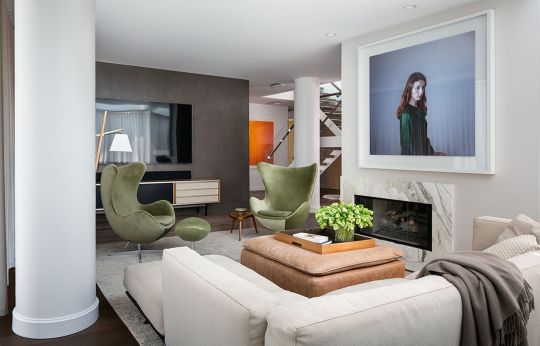
In the realm of interior design, creating visually stunning spaces is only one piece of the puzzle. Equally important is ensuring that these spaces are functional, comfortable, and conducive to the well-being of their occupants. At the heart of designing for functionality lies the principle of ergonomics – the science of designing environments that optimize human performance and enhance user experience.
Let's explore why ergonomics is a critical aspect of interior education and how IIFD - Indian Institute of Fashion & Design (@iifd) integrates this essential discipline into its curriculum.
Understanding Ergonomics:
Ergonomics is the study of how people interact with their environment and the tools within it. By considering human capabilities and limitations, ergonomics seeks to design environments, products, and systems that maximize comfort, safety, and efficiency for users. In the context of interior design, ergonomics plays a crucial role in creating spaces that promote well-being and productivity while minimizing the risk of discomfort or injury.
Enhancing User Experience:
Incorporating ergonomic principles into interior design ensures that spaces are tailored to the needs and preferences of their users. Whether it's designing furniture with adjustable heights to accommodate users of different sizes or positioning workstations to minimize glare and eyestrain, ergonomics helps designers create environments that enhance user comfort, satisfaction, and overall experience.
Promoting Health and Safety:
Beyond improving comfort and usability, ergonomics also plays a vital role in promoting health and safety in interior spaces. Designing ergonomic workstations, for example, can help prevent musculoskeletal disorders such as back pain and repetitive strain injuries. Similarly, optimizing lighting, acoustics, and air quality can contribute to a healthier and more productive indoor environment.
Integrating Ergonomics into Interior Education:
Recognizing the importance of ergonomics in interior design, the Indian Institute of Fashion & Design (IIFD) integrates this essential discipline into its curriculum. Through a combination of theory, practical exercises, and hands-on projects, students at IIFD learn how to apply ergonomic principles to their design practice, ensuring that their creations are not only visually appealing but also functional, comfortable, and user-friendly.
Take Action with IIFD:
Ready to explore the intersection of design and ergonomics and unlock your creative potential in interior education? Join one of the best Interior Design Colleges in India like IIFD - Indian Institute of Fashion & Design and embark on a transformative journey towards a rewarding career in interior design. With expert faculty, industry-relevant curriculum, and state-of-the-art facilities, IIFD offers comprehensive programs that prepare you to excel in the dynamic world of interior design while prioritizing functionality, comfort, and user experience.
Visit IIFD website to learn more and take the first step towards a future in interior education with IIFD.
#Functionality#Interior Design Education#Interior Education#iifd#iifd chandigarh#interiors#Interior Designing#Interior Design Courses#Education#Interior Design Careers#careers#interior design
1 note
·
View note
Photo

Calling all Interior Design Enthusiasts!
Are you ready to take your passion for design to the next level? Join us at IIFD and embark on a journey of creativity, innovation, and excellence in interior design. Our expert faculty and state-of-the-art facilities will provide you with the skills and knowledge you need to bring your ideas to life. We can't wait to welcome you to our vibrant and inspiring community of designers.
Apply now and let's make your design dreams a reality!
#interior design#interior design course#interior designing#interior design college#iifd#career#interior design education
0 notes
Text
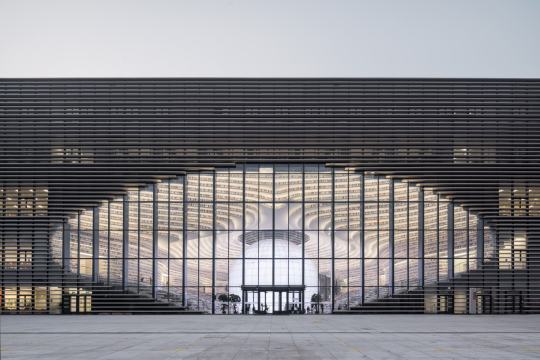



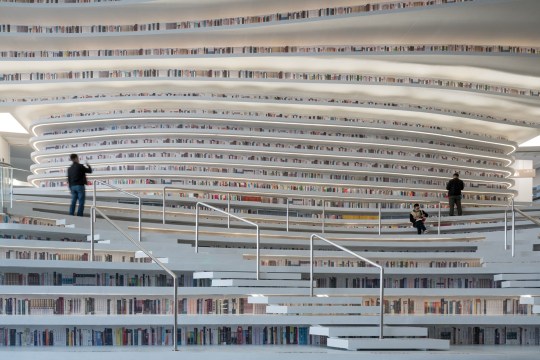



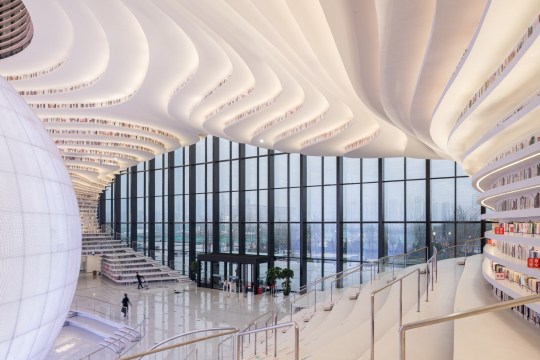
TIANJIN BINHAI LIBRARY
MVRDV and Tianjin Urban Planning and Design Institute (TUPDI) have completed Tianjin Binhai Library as part of a larger masterplan to provide a cultural district for the city. The 33,700m2 cultural centre featuring a luminous spherical auditorium and floor-to-ceiling cascading bookcases functions not only as an education centre but as a social space and connector from the park into the cultural district.
Tianjin, China
By MVRDV + Tianjin Urban Planning and Design Institute
#architecture#design#interiors#MVRDV#china#Tianjin Binhai Library#Luminous spherical auditorium#floor to ceiling bookcase#education center#cultural district#building
192 notes
·
View notes
Text
Low Budget Interior Designers in Chennai
Low Budget Interior Designers in Chennai Looking for an affordable interior designer in Chennai? Even if you’re on a budget, you can still get style for your home. This article explores low-cost interior design services in Chennai along with tips to save. Factors Influencing Low Budget Interior Design Costs Several things impact how much you’ll …
#interior design#interior design careers#interior design education#interior design services#interior design consultation
0 notes
Text

A Rug, a Praxis Project by Nahil Bishara, (remote study through correspondence), Chicago School of Interior Design, Chicago, IL, 1960-1964 [The Nahil Bishara Collection, The Palestinian Museum Digital Archive, The Palestinian Museum, Birzeit]
#design#art#design education#art education#interior design#textile#pattern#embroidery#handwriting#notation#school#nahil bishara#the nahil bishara collection#the palestinian museum digital archive#the palestinian museum#1960s
156 notes
·
View notes
Text

The stone facade and courtyard is inviting.
#stone facade#stone house#courtyard#indoor outdoor living#glass double entry doors#glass door#dining and entertaining#fine dining#dining room#architecture#contemporary architecture#contemporary home#contemporary design#design education#may#spring#toya's tales#style#toyastales#toyas tales#interior design#exterior#design evolution#design elements#design engineering#home improvement#home design#home & lifestyle
26 notes
·
View notes
Text
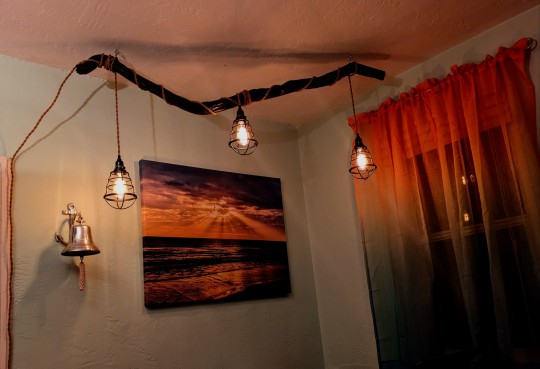

Dim Bright
I've been working on this driftwood stick for a couple weeks off and on. I burnt this 5 ft. crooked piece of driftwood with a torch and chard some spots, soaked it in oil and put a glossy lacquer coating on it. The lights are dimmable. The canvas photo I had blown up to be a 30" x 40" and it's a photo I captured shortly after moving to Florida. It kinda gave me confirmation that I'm in the right spot. If you zoom in, there is heart shaped cloud and a seagull taking a left turn.
I just wanted a mood light and it was a vision I had and thought it would go with my tropical theme and accent the canvas.
I'm a believer in shadows because it's important to do your own personal shadow work to raise our vibration. 👇
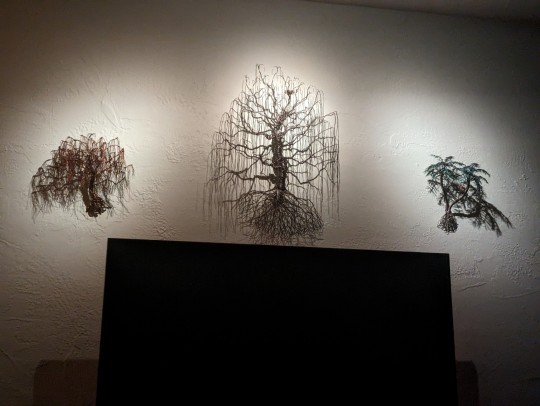
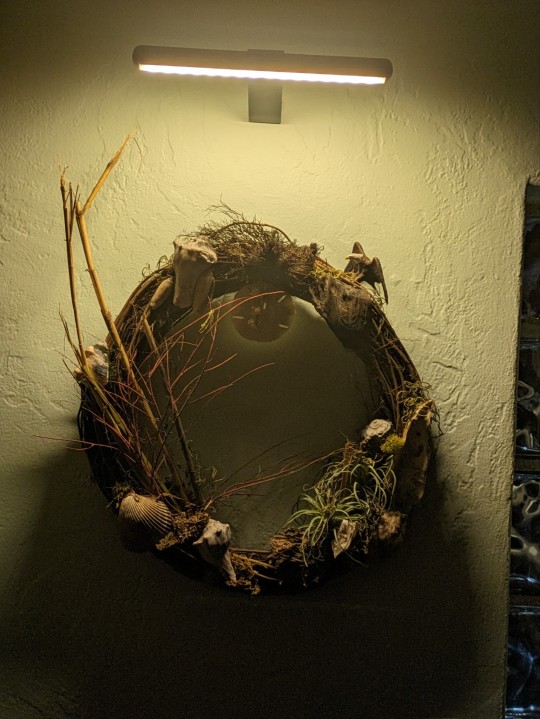
This wreath I can take down and put up a good steel tipped dartboard.
I hope everyone is doing well & do whatever makes you happy & brings joy in your life. 💫
#pay attention#educate yourselves#educate yourself#knowledge is power#reeducate yourself#reeducate yourselves#think for yourselves#think about it#think for yourself#hobby#crafts#my creations#interior design#be happy#find your passion#lights#shadow work#wire trees#artists#artistic#my gifts#talent#creative minds
8 notes
·
View notes
Text
Taking Advantage of Technology in Interior Design

In today's digital age, technology has revolutionized virtually every aspect of our lives, and interior design is no exception. From conceptualization to implementation, technology has become an invaluable tool for interior designers, enabling them to visualize, plan, and execute projects with unprecedented precision and efficiency. Let's explore how designers are taking advantage of technology to push the boundaries of creativity and innovation in interior design, and how you can join the forefront of this exciting evolution.
Visualizing Possibilities: The Power of 3D Rendering
Gone are the days of relying solely on 2D floor plans and sketches to communicate design concepts. Thanks to advancements in 3D rendering technology, interior designers can now create realistic, immersive visualizations of their designs, allowing clients to virtually experience spaces before they are built. 3D rendering enables designers to convey their ideas more effectively, iterate on designs with greater flexibility, and make informed decisions about materials, finishes, and spatial arrangements. By harnessing the power of 3D rendering, designers can bring their visions to life in stunning detail and clarity.
Streamlining Workflows: The Rise of BIM
Building Information Modeling (BIM) has revolutionized the way interior designers collaborate with architects, engineers, and contractors throughout the design and construction process. BIM software allows designers to create detailed digital models of buildings and interior spaces, incorporating information about materials, systems, and construction methods. By centralizing project data and facilitating real-time collaboration, BIM streamlines workflows, reduces errors, and improves project coordination, ultimately leading to more efficient and cost-effective outcomes.
Designing with Precision: CAD Software
Computer-Aided Design (CAD) software has long been a staple tool in the arsenal of interior designers, enabling them to create precise, detailed drawings and plans with ease. CAD software allows designers to experiment with different layouts, furniture arrangements, and architectural elements, refining their designs until they achieve the desired result. With features such as parametric modeling, 3D modeling, and drafting tools, CAD software empowers designers to work with precision and accuracy, ensuring that every detail is carefully considered and executed.
Embracing Virtual Reality: Immersive Design Experiences
Virtual Reality (VR) technology is revolutionizing the way interior designers present and experience their designs. By donning a VR headset, clients can step into virtual replicas of their future spaces, exploring every detail from different perspectives and gaining a deeper understanding of the design concept. VR technology not only enhances communication and collaboration between designers and clients but also allows designers to identify potential issues and make adjustments early in the design process. By embracing VR technology, designers can create immersive design experiences that captivate clients and bring their visions to life in new and exciting ways.
Join the Technological Revolution at IIFD
At IIFD - Indian Institute of Fashion and Design (@iifd), we recognize the transformative power of technology in interior design and the opportunities it presents for aspiring designers to innovate and excel in the field. Our interior design programs are designed to equip students with the skills, knowledge, and expertise needed to harness the latest technological tools and techniques and create cutting-edge designs that push the boundaries of creativity and innovation.
Ready to embrace the future of interior design with technology? Explore our interior design programs at one of the best Interior Designing Colleges in India IIFD and discover how you can turn your passion for design into a career that leverages the latest technological advancements.
Visit IIFD today to learn more about our courses and start your journey towards becoming a skilled and visionary interior designer. Together, let's harness the power of technology to create spaces that inspire and transform.
#Technology in Interior Design#Interior Design#Technology#iifd#education#iifd chandigarh#careers#Interior Designing#Careers#Interior Design Education#Interior Design Careers
0 notes